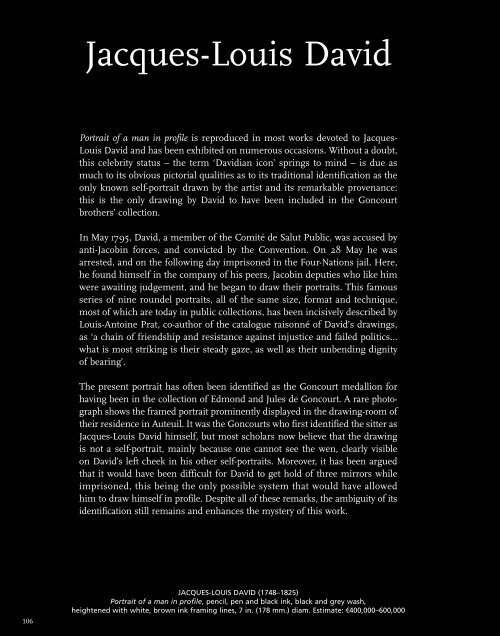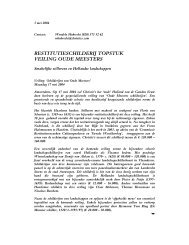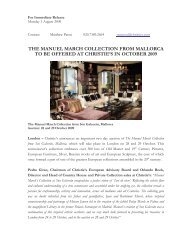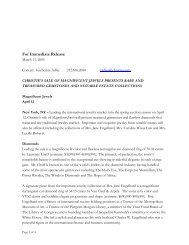Yves Saint Laurent Pierre Bergé - Christie's
Yves Saint Laurent Pierre Bergé - Christie's
Yves Saint Laurent Pierre Bergé - Christie's
You also want an ePaper? Increase the reach of your titles
YUMPU automatically turns print PDFs into web optimized ePapers that Google loves.
106<br />
Jacques-Louis David<br />
Portrait of a man in profile is reproduced in most works devoted to Jacques-<br />
Louis David and has been exhibited on numerous occasions. Without a doubt,<br />
this celebrity status – the term ‘Davidian icon’ springs to mind – is due as<br />
much to its obvious pictorial qualities as to its traditional identification as the<br />
only known self-portrait drawn by the artist and its remarkable provenance:<br />
this is the only drawing by David to have been included in the Goncourt<br />
brothers’ collection.<br />
In May 1795, David, a member of the Comité de Salut Public, was accused by<br />
anti-Jacobin forces, and convicted by the Convention. On 28 May he was<br />
arrested, and on the following day imprisoned in the Four-Nations jail. Here,<br />
he found himself in the company of his peers, Jacobin deputies who like him<br />
were awaiting judgement, and he began to draw their portraits. This famous<br />
series of nine roundel portraits, all of the same size, format and technique,<br />
most of which are today in public collections, has been incisively described by<br />
Louis-Antoine Prat, co-author of the catalogue raisonné of David’s drawings,<br />
as ‘a chain of friendship and resistance against injustice and failed politics…<br />
what is most striking is their steady gaze, as well as their unbending dignity<br />
of bearing’.<br />
The present portrait has often been identified as the Goncourt medallion for<br />
having been in the collection of Edmond and Jules de Goncourt. A rare photograph<br />
shows the framed portrait prominently displayed in the drawing-room of<br />
their residence in Auteuil. It was the Goncourts who first identified the sitter as<br />
Jacques-Louis David himself, but most scholars now believe that the drawing<br />
is not a self-portrait, mainly because one cannot see the wen, clearly visible<br />
on David’s left cheek in his other self-portraits. Moreover, it has been argued<br />
that it would have been difficult for David to get hold of three mirrors while<br />
imprisoned, this being the only possible system that would have allowed<br />
him to draw himself in profile. Despite all of these remarks, the ambiguity of its<br />
identification still remains and enhances the mystery of this work.<br />
JACQUES-LOUIS DAVID (1748–1825)<br />
Portrait of a man in profile, pencil, pen and black ink, black and grey wash,<br />
heightened with white, brown ink framing lines, 7 in. (178 mm.) diam. Estimate: v400,000–600,000

















